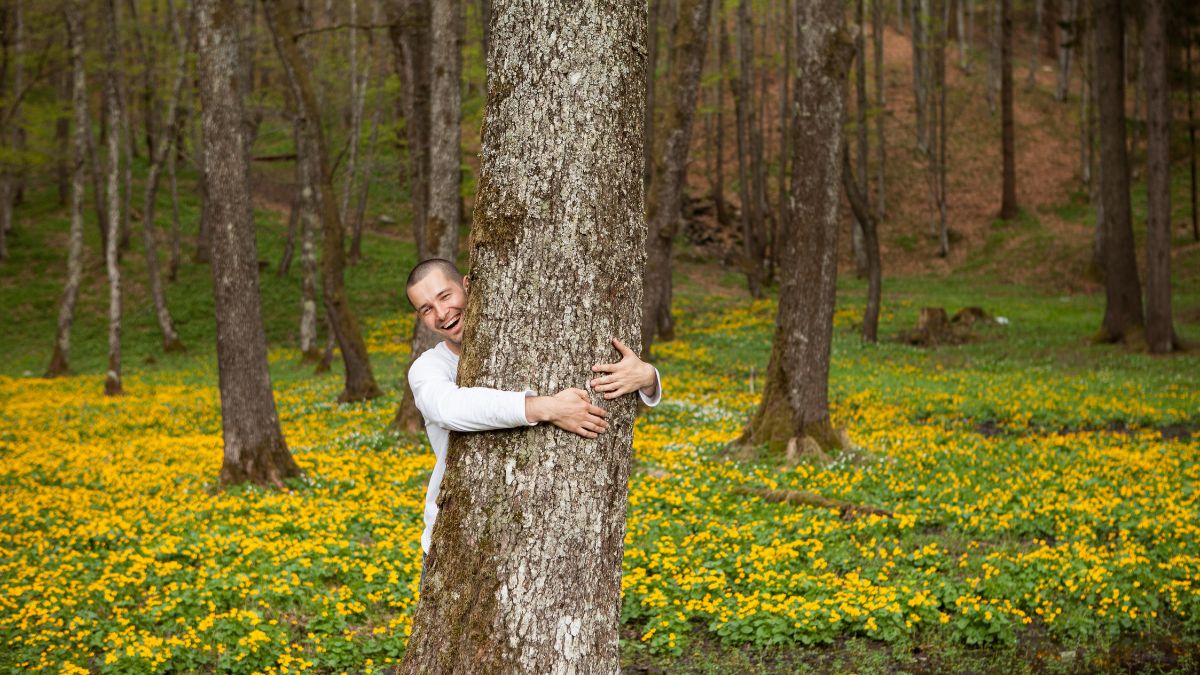It’s never been easier to be a couch potato. Over the last few decades, we’ve accumulated reasons to stay indoors, in front of screens, protected from the outer world.
Today, more of us work at a desk, many of which are in our own homes; we have a smorgasbord of digital entertainment options keeping us occupied; even when we do get out, we stay glued to the screens of our smartphones.
By 2050, it’s projected over two-thirds of people will live in cities. Our nomadic and pastoral lives behind us, our connection to nature looks to be slowly receding.
Or is it? Despite all of that, most of us recognise the significance of nature for our mental health—we put plants in our homes, tend to gardens, find parks for a walk, and even pay good money to go on retreats and digital detoxes.
Even when the world seems to pull us away from nature, we’re compelled to find it where we can, and science is exploring the reasons why in a field called ‘ecopsychology’.
What Is Ecopsychology?
Ecopsychology pulls together psychology (the study of the mind and brain) and ecology (the study of relationships among living things).
While many people—especially writers and philosophers—speculated on the important link between people and nature, the field of ecopsychology largely came into existence through Robert Greenway’s writing on the synthesis of psychology and ecology in the 1960s.
He started teaching at Sonoma State University in 1969, giving courses in ‘transpersonal psychology’ and ‘wilderness therapy’. He helped make this relationship a legitimate branch of science, which at this point he called psycho-ecology.
It wasn’t until 1992 that writer Theodore Roszak would coin the term ecopsychology in his book ‘The Voice of the Earth’, following it up in 1995 with the anthology ‘Ecopsychology: Restoring the Earth, Healing the Mind.’
Since then the studies have been flowing, elucidating nature’s therapeutic effects on the mind, how time spent in green spaces impacts our physical and mental health, and the problems that occur when we lose touch with mother nature’s influence.
Below are three of the biggest theories and concepts with their roots in ecopsychology, along with interesting findings and studies:
Attention Restoration Theory
In the 1970s, not long after Robert Greenway started his foray into psycho-ecology, Rachel and Stephen Kaplan devised the Attention Restoration Theory.
They hypothesised that time spent in natural environments helps replenish mental energy and willpower that you can then use to focus more effectively.
A city or work environment can demand a lot of attention which slowly takes its toll, but scenes of nature promote ‘soft fascination’, where you pay attention to something effortlessly and your energy levels are restored.
They suggested this restoration occurs over 4 different states of attention:
- Clearer head: any concerns and worries that were demanding attention are gently cleared away.
- Mental fatigue recovery: the tiredness you feel after prolonged periods of direct attention is refreshed.
- Soft fascination: you become engaged by the world around you, providing a calm internal state requiring only low levels of attention. You need enough mental bandwidth left over for the next reflection stage.
- Reflection and restoration: you relax enough that you can reflect on life, some mind wandering can occur while still being present in the current surroundings.
We experience some restoration of energy after simply taking a break from life’s demands, but the Attention Restoration Theory points more specifically to a break in the presence of nature, and a number of studies support it.
In 1991, a study found that people who vacationed in the wilderness performed better in subsequent tasks of directed attention, while those who did not take a vacation or vacationed in an urban setting performed worse.
A study involving Stephen Kaplan showed that a 50-minute walk amongst the trees can improve cognitive function for those with depression, while city streets offered no such gain.
But it doesn’t seem to require that we spend a lot of time physically immersed in natural environments for this restorative effect to take place, in some cases looking at pictures can help.
A 2005 study had participants perform sustained attention tasks before and after looking at photos of restorative environments, non-restorative environments, or geometric patterns. The restorative photos still lead to improved performance.
Similarly, another study found that university students who had a window with a view to nature performed better than those without it.
Merely looking at nature seems to refresh our mental energy, but there may be even more than attentional benefits: some research shows people in hospital recover faster with a view to nature.
Forest Bathing (Shinrin-Yoku)
In 1982, the director of the Japanese Ministry of Agriculture, Forestry and Fisheries, Tomohide Akiyama, introduced the concept of ‘shinrin-yoku’, translated as ‘forest bathing’.
Between 2004 and 2012, the Japanese government invested over $4 million into researching the benefits of nature therapy, with over 48 forest therapy trials being registered across Japan.
In practice, it involves calmly walking among the trees and wilderness. You shouldn’t have any devices with you, and it’s not to be too strenuous, just a gentle and mindfully engaged stroll through nature.
A lot of science has come out in favour of forest bathing and nature therapy, proving its worth for both physical and mental health and wellbeing, and making it a worthy addition to field of ecopsychology.
A 2007 study of almost 500 people found shinrin-yoku significantly lowered hostility and depression while increasing liveliness, they also noted that there were larger reductions in stress for those who were more stressed to begin with.
In other cognitive domains, one study found that backpackers were 50 per cent more creative after 4 days of hiking; another found nature walks help alleviate symptoms of ADHD; a third showed nature and gardening promoted calmness and helped those in a psychiatric unit.
A massive study of nearly 20,000 people found that spending over 2 hours in nature per week led to people reporting much better health and well-being. The two hours didn’t have to come all at once, it could be spaced over several sessions.
The benefits extend far beyond the psychological realm, too.
A review of the research on shinrin-yoku concluded: “forest environments promote lower concentrations of cortisol, lower pulse rate, lower blood pressure, greater parasympathetic nerve activity, and lower sympathetic nerve activity than do city environments.”
Biophilia
The psychoanalyst Eric Fromm described biophilia in 1973 as “the passionate love of life and of all that is alive.” Then in 1984, the biologist Edward O. Wilson wrote a book on the subject, aptly titled ‘Biophilia’, where he claimed this love was partially genetic.
It is the notion that we’re driven to connect with nature, and we have this drive from birth. We evolved in these diverse natural landscapes, and it was advantageous for us to connect with them.
It’s also likely that biophilia plays a significant part in eco-anxiety, the fear of environmental collapse and degradation. We feel like an intense wrong has been committed when nature is needlessly destroyed.
Considering all the benefits nature therapy has, we should be motivated to reap these rewards wherever and whenever we can. And it seems that many of us do.
Rather than relying on wilderness treks and trips to lush parks (amazing as they are), many people invite nature into the home and garden, while governments are increasingly realising the benefits of bringing nature into the city.
When we invite nature with us into the world’s we’re increasingly inhabiting, we reap a host of rewards that scale both the personal and the social strata:
Studies have found that when we invite plants into the home and workspace, it reduces stress, improves our mood in as little as 5 minutes, boosts mental health, and enhances job satisfaction.
When we live in areas with nearby green spaces, we experience less distress, even after adjusting for income, education, and employment.
We also have an advantage in heart and metabolic health equivalent to a $20,000 gain in income, and are less likely to suffer from 15 different diseases, including diabetes, asthma, and heart disease.
Green spaces also promote social cohesion—a study of 2,000 UK residents found exposure to nature increased community cohesion and reduced crime rates; another showed a reduction in assault, robbery, and burglary.
Nature Therapy
If we lived without plants and green spaces nearby it seems our mental health would deteriorate, and society itself might just fall apart at the seams.
It’s great then, to see we might all have this innate sense of biophilia, and all the research that ecopsychology has found in its favour.
Unfortunately, the modern world keeps finding ways to pull us in another direction. Several studies have found we spend less time in nature, and more time looking at screens.
Technology has a lot to offer, but there’s a balance to be had, and right now it’s lopsided.
Nature isn’t going to entertain us like Netflix does, or make us productive like Google, but it’s essential for keeping your mind and body ticking along in good order. So best make time for it.
Nature therapy has truly earned its place as a therapeutic. It’s not one we might often think about, it doesn’t grab our attention like new toys and technologies, but stopping to smell the roses, watch the leaves in the wind, and listen to the birds sing, can work real magic.
- Chephren Lake And The Mistaya River Valley - July 1, 2024
- Mindfulness And The 4 Steps of Attention Restoration Theory - June 29, 2024
- 3 Pillars Of An Ecotourism Marketing Strategy For Selling Travel Experiences - June 29, 2024



